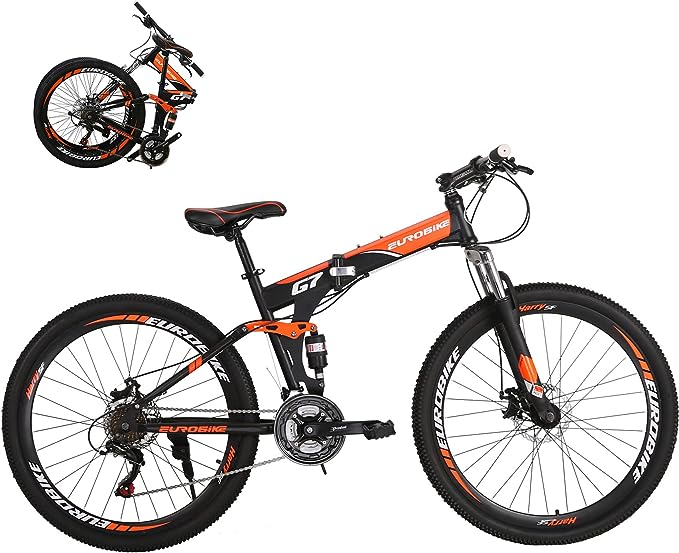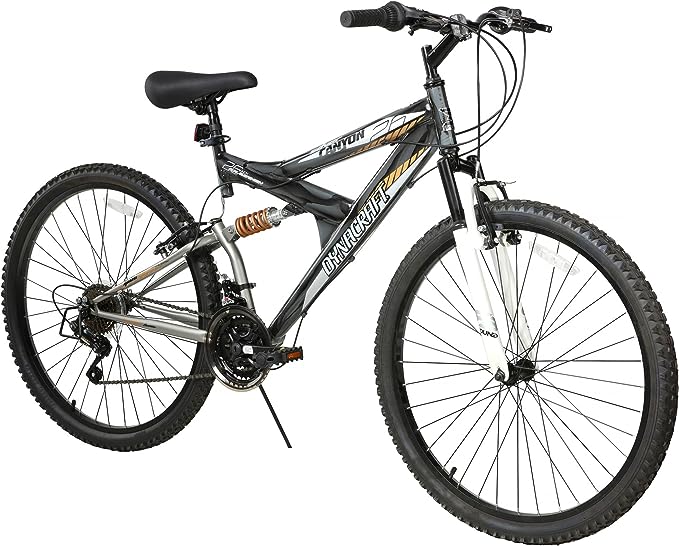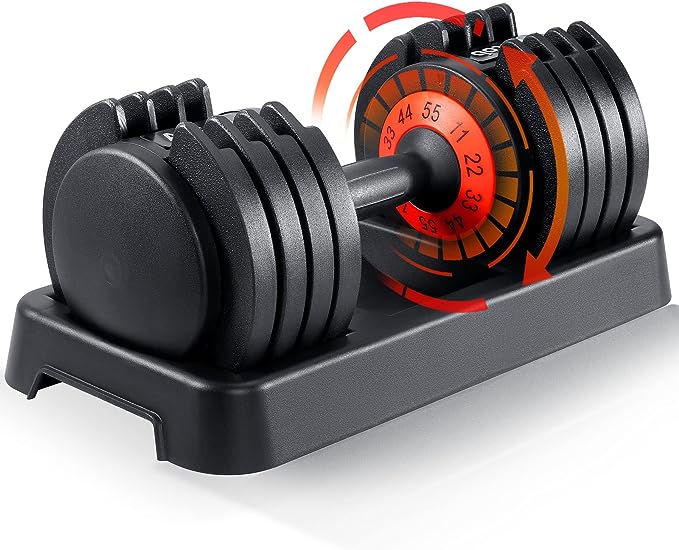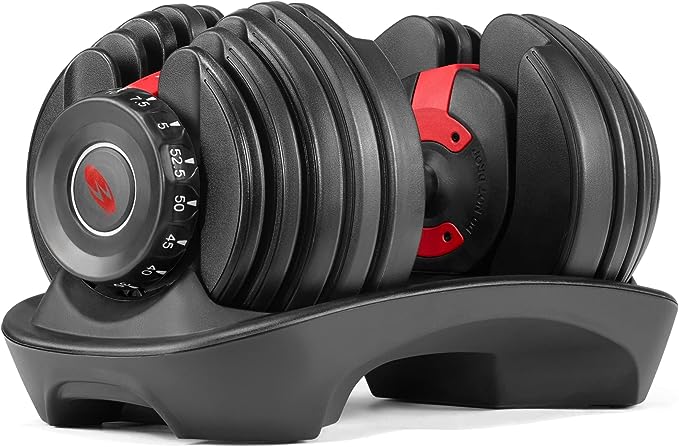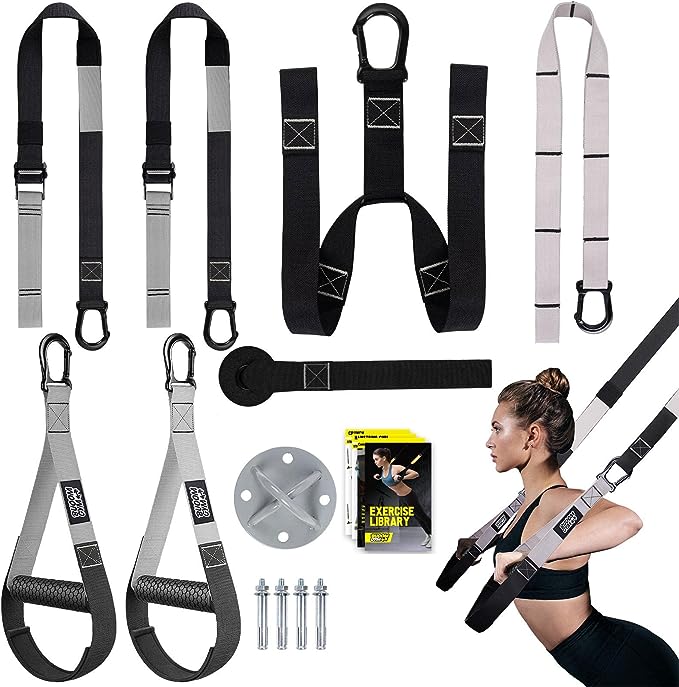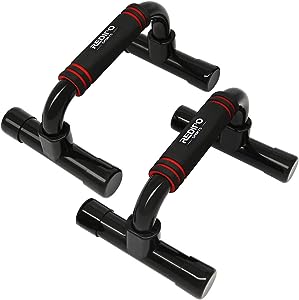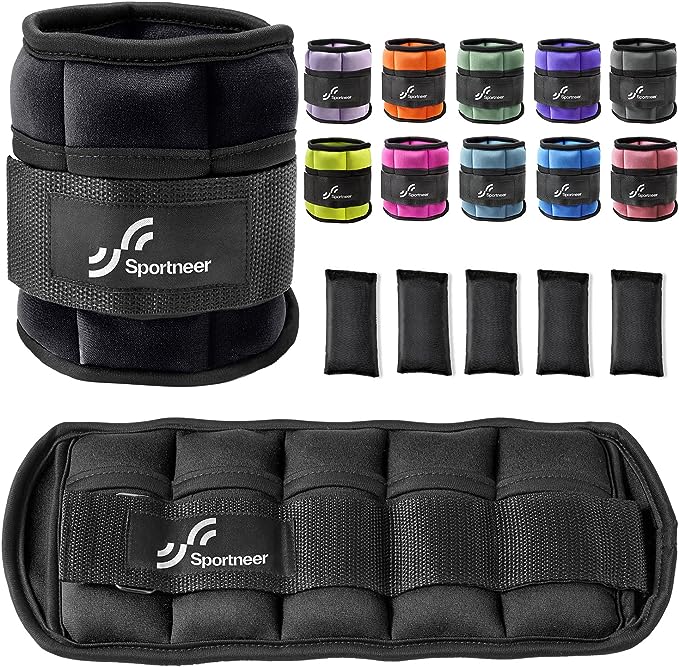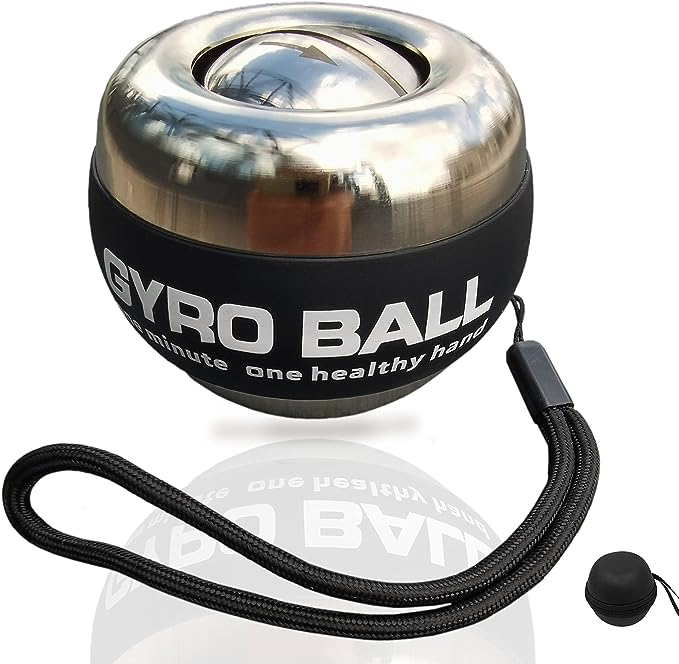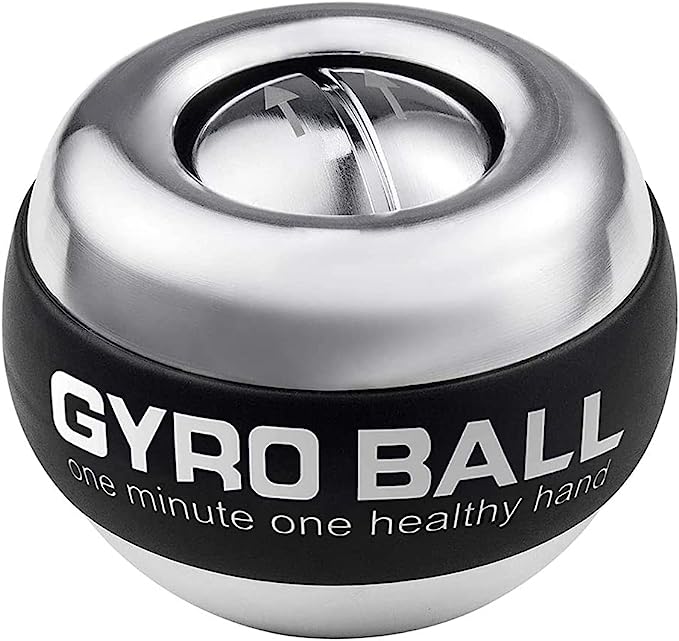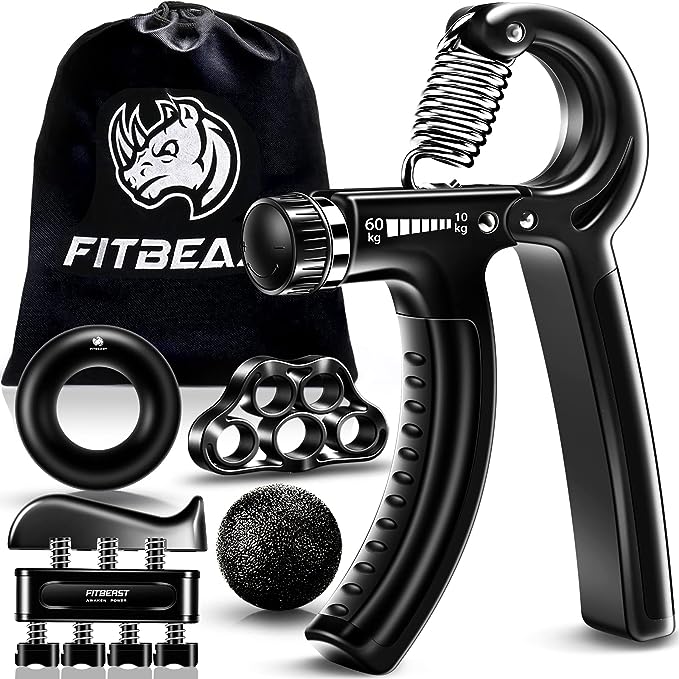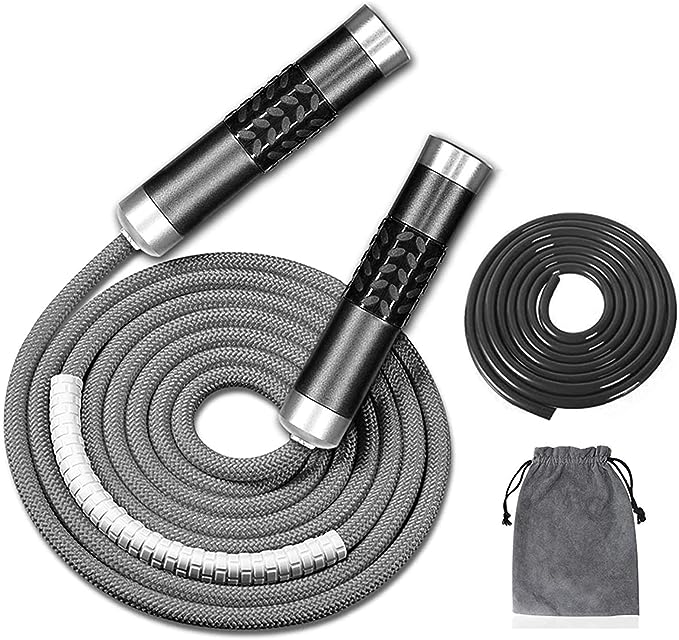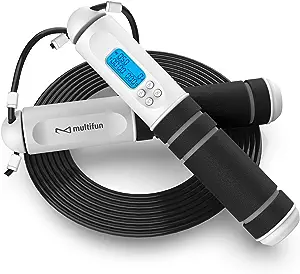Trucker ClubHouse
Fit Club
a club to help guide you to a fit & healthy lifestyle
The Fit Club provides support, instruction & motivation to not only help you lose that extra weight you’ve been carrying around but also provide detailed guidance on diet and exercise especially tailored to truckers to help get you in the best shape of your life! If you’re ready to get healthy, lose that extra weight and get into the best shape of your life, join the Fit Club community and let’s get to work on the new you!
join our performance contests to see who will hit their goal the fastest just to add a little bit of fun to all your hard work, and some very cool prizes!

Welcome to the Fit Club – where we redefine the path to healthier living for our trucking heroes as we combat the grave health concerns that plague our profession. As dedicated drivers crisscrossing the highways, we understand the toll that sedentary routines, long hours behind the wheel, irregular schedules and the temptations of convenient yet unhealthy eating can take on both your physical and mental well-being. That’s why we’ve come together to create a supportive community that promotes healthy & happy living on the open road.
We believe that every mile traveled should be an opportunity to improve our physical and mental health. That’s why the Fit Club is more than just another online fitness community; it’s a family of dedicated truckers committed to revolutionizing the trucking industry’s approach to health and fitness while also providing a lifeline to a healthier and happier life on the road. We are here to support you, inspire you and equip you with the tools you need to fight against obesity, lack of movement, diabetes and hypertension.
Our mission is simple yet powerful: to unite truckers from all corners of the country and inspire, support & celebrate their journeys to lead healthier lives on and off the road. Whether you’re a seasoned road warrior or just starting your journey, our club is open to all truckers who want to make positive changes in their lives. Here, you’ll find like-minded individuals who share your passion for trucking and are committed to leading healthier, happier lives.
Joining our online club means gaining access to a wealth of resources tailored specifically for truckers. From on-the-go custom workout routines that can be done in the tightest of spaces to dieting & nutrition tips for eating well on the go, we’ve got your back every mile of the way. Whether you’re looking to shed a few pounds, improve your strength, boost your energy levels or simply connect with fellow truckers who understand your unique lifestyle, this is the place for you. Our supportive community shares success stories, challenges and encouragement, making every step of your health transformation a shared experience with fellow truckers who understand the triumphs and challenges of this unique profession.
Get ready to revitalize your health & renew your energy. Let’s steer ourselves toward a stronger, fitter & healthier future together, and show the world that truckers are not only masters of the road but also champions of their own well-being. Join us in this journey to improved well-being and wear your membership with pride as we prove that truckers can lead the charge for healthier living!
Join us, and together, we’ll steer your path toward a healthier future—because your life depends on it, and we are committed to making a difference in every mile you drive.
The Diet
Intermittent Fasting

Intermittent fasting is a dietary approach that cycles between periods of eating and fasting. It doesn’t prescribe specific foods to eat but focuses on when to eat them, making it fairly easy to accomplish. The primary goal of intermittent fasting is to extend the period of time the body spends in a fasted state, during which it depletes its glycogen stores and starts using stored fat for energy. During the fasting period, you consume no calories and are only allowed water, black coffee or unsweetened tea (non-caloric beverages). Intermittent fasting has gained popularity for its potential benefits for weight loss, overall health and a whole lot more. Keep reading to find out all the benefits it can offer to a profession like trucking.
Weight Loss

By restricting eating hours and/or calories, intermittent fasting can lead to a calorie deficit, resulting in weight loss.
Here’s how fasting may help with your weight loss journey:
Calorie Restriction: By limiting the eating window, there is a natural reduction in the number of meals and snacks throughout the day. This restriction often leads to a decrease in overall caloric intake, which is a fundamental factor for weight loss. If you eat fewer calories than your body needs for maintenance, you create a caloric deficit, which can lead to weight loss over time.
Improved Insulin Sensitivity: Intermittent fasting can help improve insulin sensitivity, which is especially beneficial for individuals with type 2 diabetes or those at risk of developing it. Insulin is a hormone that regulates blood sugar levels and plays a role in fat storage. When you eat, your body releases insulin to help regulate blood sugar levels and stores excess glucose as fat. By fasting for longer periods, your body becomes more sensitive to insulin, using it more effectively to reduce the risk of excess glucose being stored as fat. This can promote fat burning and weight loss. Further, researchers have reported that intermittent fasting can lead to comparable decreases in hemoglobin A1c (https://www.mdpi.com/2076-328X/7/1/4/htm)
Enhanced Weight Loss & Fat Reduction: During the fasting period, when your body is in a fasted state and has depleted its immediate glycogen (glucose / stored carbohydrates) reserves, it starts tapping into fat stores for energy. This process, known as lipolysis, encourages fat burning which may help with weight loss, particularly when combined with physical activity.
Hormonal Effects: Intermittent fasting can impact the secretion of certain hormones related to appetite and metabolism, such as ghrelin and leptin. Ghrelin is known as the “hunger hormone” because it stimulates appetite, while leptin helps regulate energy balance and suppresses hunger. Some studies suggest that fasting may help reduce hunger hormones and increase feelings of fullness, leading to decreased food intake, and may help reset ghrelin and leptin hormone levels leading to reduced hunger and improved appetite control.
Cellular Repair & Enhanced Autophagy: During fasting periods, the body activates cellular repair processes and autophagy. Autophagy is a cellular process where cells remove damaged components and other waste materials, promoting overall cellular health. Fasting has been shown to stimulate autophagy, which can help improve cellular function and potentially support weight loss.
Increase in Metabolism: Some research indicates that intermittent fasting may lead to a modest increase in resting metabolic rate, which means you burn slightly more calories at rest.
Reduction in Snacking: With a limited eating window, there is less opportunity for mindless snacking or eating out of boredom, which can contribute to excess calorie intake.
Simple and Sustainable: Fasting is relatively easy to incorporate into daily life and may be more sustainable for some individuals compared to more restrictive diets. It doesn’t require specific meal plans or complicated rules, making it easier to follow long-term.
People with diabetes who take insulin or medication should consult with their doctor before starting a diet, as they must maintain their blood sugar levels. Failure to maintain correct blood sugar can result in low blood sugar, which can lead to a coma or even death.
It’s essential to note that while fasting can be effective for weight loss, it may not be suitable for everyone. Individual results may vary, and it’s crucial to listen to your body and if you have underlying health conditions or concerns, always consult with your physician before starting a fasting regimen. Additionally, sustainable weight loss and overall health improvement are best achieved when combined with a balanced diet, regular physical activity and other lifestyle factors.
Diabetes

Intermittent fasting has been found to have several potential benefits for individuals with diabetes, particularly type 2 diabetes. It’s important to note that before starting any fasting regimen, individuals with diabetes should consult with their healthcare provider or a registered dietitian to ensure it aligns with their specific health needs.
Here are some ways intermittent fasting may positively impact diabetes:
Improved Insulin Sensitivity: Studies have shown that intermittent fasting can lead to improved insulin sensitivity, which means the body becomes more efficient at utilizing insulin to regulate blood sugar levels. This is crucial for individuals with diabetes, especially those with type 2 diabetes who often have insulin resistance, as it can help improve blood sugar control and reduce insulin resistance. It’s. When the body enters a fasting state, it becomes more responsive to insulin, allowing for better regulation of blood sugar levels.
Weight Management: Intermittent fasting can aid in weight loss or weight maintenance, which is crucial for managing diabetes. Excess weight is a significant risk factor for developing type 2 diabetes or worsening diabetes symptoms. For individuals with type 2 diabetes, achieving and maintaining a healthy weight is crucial for better blood sugar control and overall health. By helping individuals consume fewer calories and potentially lose weight, fasting can positively impact blood sugar control and overall health.
Reduced Postprandial Glucose Levels / Blood Sugar Regulation: Postprandial glucose refers to the increase in blood sugar levels after eating. By restricting the eating window, there are fewer spikes in blood sugar levels throughout the day since food consumption is limited to a specific period. Therefore, individuals with diabetes may experience reduced post-meal spikes and dips in blood sugar, leading to better glycemic control by reducing the risk of hyperglycemia and hypoglycemia. Fasting may help in controlling blood sugar levels and reduce the risk of hypoglycemia and hyperglycemia.
Reduced Need for Medication: Some people with type 2 diabetes who adopt intermittent fasting may find that their blood sugar levels improve to the point where they require less diabetes medication. However, any adjustments to medication should only be made under the guidance of a healthcare professional.
Enhanced Weight Loss & Fat Reduction: During the fasting period, the body depletes its glycogen stores and starts burning stored fat for energy, leading to reductions in excess body fat. This can be especially beneficial for people with type 2 diabetes, because a reduction of excess body fat in the liver and pancreas can contribute to improved insulin sensitivity and better diabetes management.
Potential Beta Cell Function Improvement: Some animal studies suggest that intermittent fasting may improve beta cell function in the pancreas, the cells responsible for producing insulin. This could have positive implications for individuals with type 2 diabetes.
Circadian Rhythm Regulation: Following a consistent eating window can help regulate the body’s internal clock or circadian rhythm. Studies have suggested that disruptions in circadian rhythms may play a role in insulin resistance and diabetes. By adhering to a fasting schedule, it’s possible to promote better metabolic function.
Cardiovascular Benefits: Intermittent fasting has been associated with reducing risk factors associated with cardiovascular disease, including blood pressure, cholesterol levels and markers of inflammation, which is important because diabetes increases the risk of heart-related complications. This is particularly relevant for individuals with diabetes, as they are at higher risk for cardiovascular complications.
Simplified Meal Planning: Some people find fasting easier to follow and more flexible than traditional calorie-restricted diets, as they don’t need to worry about multiple meals and snacks throughout the day.

It’s important to emphasize that intermittent fasting should be done in a controlled manner, and blood sugar levels should be closely monitored during fasting periods. For some individuals with diabetes, especially those on insulin or other medications that can cause hypoglycemia, fasting may not be recommended or may require adjustments to medication dosages. Overall, while fasting may offer potential benefits for some individuals with diabetes, it should be approached with caution and under proper medical supervision.
Intermittent fasting can be a powerful tool when incorporated into a comprehensive diabetes management plan that includes a balanced diet, regular physical activity and proper medical supervision. Every individual’s response to intermittent fasting may vary, so it’s crucial to work closely with healthcare professionals to determine the most suitable approach and ensure safe and effective diabetes management.
While intermittent fasting can be beneficial for some people, it may not be suitable for everyone. Pregnant or breastfeeding women, individuals with a history of eating disorders and those with certain medical conditions should avoid intermittent fasting or do it under medical supervision. As with any dietary change, it’s essential to consult with a healthcare professional before starting intermittent fasting to ensure it’s safe and appropriate for individual health needs.
Heart Health
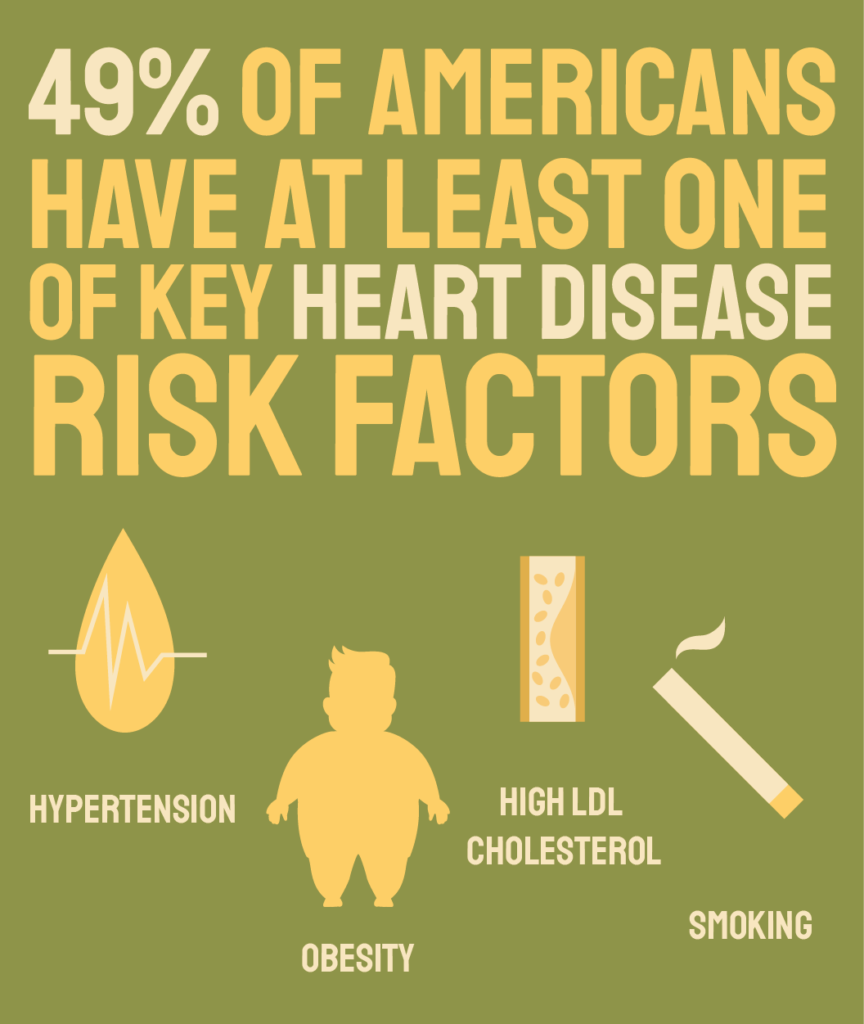
Various studies and research have shown that intermittent fasting has been associated with improving various risk factors associated with heart disease, such as blood pressure, cholesterol levels and inflammation. Here are some ways intermittent fasting may positively impact your heart health:
Weight Management: Intermittent fasting can help with weight loss and weight management. Excess body weight is a risk factor for heart disease, and shedding those extra pounds through intermittent fasting can improve heart health.
Improvement in Cholesterol Levels: Some studies have shown that intermittent fasting can lead to a reduction in total cholesterol levels, LDL cholesterol (the “bad” cholesterol) and triglycerides. Lowering these lipid levels can contribute to a decreased risk of developing cardiovascular diseases.
Reduced Blood Pressure: Intermittent fasting may result in lower blood pressure readings, which is essential for heart health. High blood pressure (hypertension) is a significant risk factor for heart disease, and any intervention that helps control it can be beneficial.
Enhanced Insulin Sensitivity: Intermittent fasting can improve insulin sensitivity, reducing the risk of developing type 2 diabetes. Diabetes is a significant risk factor for heart disease, so better insulin sensitivity can indirectly benefit heart health.
Inflammation Reduction: Chronic inflammation in the body can contribute to the development of heart disease. Some studies suggest that intermittent fasting can help reduce markers of inflammation, potentially benefiting heart health.
Improved Blood Sugar Control: Intermittent fasting has shown promise in regulating blood sugar levels, which is essential for individuals with diabetes or those at risk of developing the condition. Better blood sugar control can lower the risk of cardiovascular complications related to diabetes.
Promotion of Autophagy: During fasting periods, the body undergoes a process called autophagy, where it breaks down and recycles damaged cellular components. Autophagy helps maintain cellular health and may have protective effects on the heart.
Enhanced Heart Function: Some animal studies suggest that intermittent fasting might improve heart function and protect against heart-related issues.
It’s important to note that individual responses to intermittent fasting can vary, and it may not be suitable for everyone, especially those with certain medical conditions or specific nutritional needs. If considering intermittent fasting as part of a heart-healthy lifestyle, it’s crucial to do so under the guidance of a healthcare professional to ensure that it aligns with individual health goals and needs.
Brain Health

Intermittent fasting has shown potential brain health benefits, including neuroprotective effects and potentially helping improve cognitive function, based on both animal and some human studies. While more research is needed to fully understand the mechanisms and long-term effects, here are some ways intermittent fasting may positively impact brain health:
Neuroprotection: Intermittent fasting may offer neuroprotective effects, potentially reducing the risk of neurodegenerative diseases such as Alzheimer’s and Parkinson’s. Some animal studies have demonstrated that intermittent fasting can protect brain cells from oxidative stress and inflammation, which are contributing factors to neurodegeneration.
Increased Brain-Derived Neurotrophic Factor (BDNF): Intermittent fasting has been associated with higher levels of BDNF, a protein that supports the growth and maintenance of neurons. BDNF plays a crucial role in learning, memory and overall cognitive function.
Enhanced Autophagy: During fasting periods, the body engages in autophagy, a process where cells remove damaged components and recycle them. Autophagy can help clear protein aggregates and dysfunctional cellular structures in the brain, promoting healthier brain cells.
Improved Brain Plasticity: Intermittent fasting might enhance synaptic plasticity, which is the brain’s ability to reorganize and form new connections between nerve cells. This can positively impact learning and memory functions.
Reduction in Brain Inflammation: Some studies suggest that intermittent fasting can lead to a decrease in pro-inflammatory cytokines in the brain, which may help reduce chronic brain inflammation and its negative effects on cognitive function.
Regulation of Brain Glucose Metabolism: Intermittent fasting can influence how the brain utilizes glucose for energy. It has been proposed that this altered energy metabolism may have positive effects on brain health.
Mitochondrial Function: Intermittent fasting may promote mitochondrial health and efficiency. Mitochondria are the powerhouses of cells, and their optimal function is crucial for brain health.
Potential Protection Against Stroke & Brain Injury: Some animal studies have shown that intermittent fasting might offer protection against stroke and brain injury by activating cellular stress response pathways.

Further Info:
Intermittent fasting may also impact cognition. According to a 2018 review, animal studies show that restricting calories through intermittent fasting can slow signs of cognitive and motor decline. The same review suggests that these fasting methods may also help the nerves protect themselves against injury. While many of these studies have not been in humans, intermittent fasting shows promise as a remedy for some effects of aging. More extensive research is now awaited in human subjects (https://www.ncbi.nlm.nih.gov/pmc/articles/PMC5959807/)
As with any dietary or lifestyle change, it’s important to consult with a healthcare professional before attempting intermittent fasting, especially for individuals with existing health conditions or specific nutritional needs. Individual responses to fasting can vary, and what works for one person may not be suitable for another.
Liver Disease
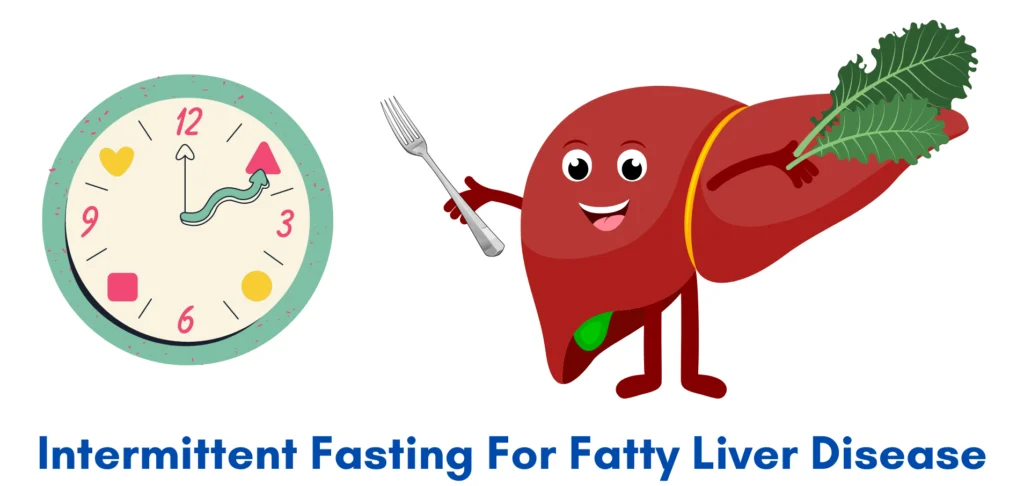
Intermittent fasting has shown potential benefits for individuals with certain types of liver disease, particularly non-alcoholic fatty liver disease (NAFLD) and non-alcoholic steatohepatitis (NASH). Further, a study on mice on a high fat diet found that intermittent fasting protected them from obesity, inflammation, diabetes and liver disease, even when they ate the same total number of calories as mice that ate whenever they wished.
Here are some ways intermittent fasting may positively impact your liver health:
Weight Loss: Intermittent fasting can promote weight loss, and shedding excess body weight is one of the most effective ways to improve liver health in individuals with NAFLD or NASH. Weight loss helps reduce the accumulation of fat in the liver, known as hepatic steatosis, which is a key feature of these conditions.
Reduced Liver Fat Accumulation: Intermittent fasting may lead to a decrease in liver fat content, which is beneficial for those with NAFLD. Lowering liver fat can help prevent the progression of NAFLD to more severe stages, such as NASH or cirrhosis.
Improved Insulin Sensitivity: Intermittent fasting can improve insulin sensitivity, reducing insulin resistance. Improved insulin sensitivity is crucial for individuals with NAFLD or NASH, as insulin resistance is often associated with the development and progression of these liver diseases.
Inflammation Reduction: Chronic inflammation in the liver is a common feature of NAFLD and NASH. Some studies suggest that intermittent fasting can help reduce liver inflammation, potentially slowing the progression of these conditions.
Enhanced Autophagy: During fasting periods, the body undergoes autophagy, a process that involves the breakdown and recycling of damaged cellular components. Autophagy can help clear harmful substances from liver cells, supporting overall liver health.
Regulation of Lipid Metabolism: Intermittent fasting may influence lipid metabolism in the liver, leading to a decrease in the production and accumulation of harmful lipids associated with NAFLD.
Improved Liver Enzyme Levels: Elevated liver enzymes, such as alanine transaminase (ALT) and aspartate transaminase (AST), are markers of liver damage. Intermittent fasting has been associated with reductions in these liver enzyme levels in some studies.
It’s important to note that while intermittent fasting may offer benefits for individuals with NAFLD and NASH, it might not be suitable for all patients or may require careful supervision. Some individuals with liver disease may have specific nutritional needs or medical conditions that could be affected by fasting. If considering intermittent fasting as a part of a liver disease management plan, it is essential to do so under the guidance and supervision of a healthcare professional. They can assess the individual’s specific condition, provide personalized recommendations, and ensure that the fasting approach is safe and appropriate for their liver health and overall well-being.
Cancer

Intermittent fasting has shown potential benefits in the context of cancer prevention and treatment, based on various studies conducted in animal and some limited human research.
Here are some ways intermittent fasting may potentially impact cancer:
Cellular repair & Regeneration / Autophagy: During fasting periods, the body activates cellular repair processes, including autophagy, a process in which cells remove damaged components and toxins, promoting cellular repair and renewal. This could potentially help the body eliminate precancerous or damaged cells before they develop into cancerous tumors.
Reduced Insulin & Insulin-Like Growth Factor 1 (IGF-1) Levels: Intermittent fasting can lead to decreased insulin and IGF-1 levels, which are associated with cancer development and growth. Lowering these hormone levels may help reduce cancer risk.
Metabolic Adaptation in Cancer Cells: Cancer cells often rely on specific metabolic pathways for growth and survival. Intermittent fasting may alter cellular metabolism, potentially making it more difficult for cancer cells to thrive.
Blood Sugar Regulation: Time-restricted eating can help improve insulin sensitivity and regulate blood sugar levels, which might be beneficial as cancer cells often rely on glucose for growth and proliferation.
Reduction of Chronic Inflammation: Chronic inflammation is linked to an increased risk of cancer. Some studies suggest that intermittent fasting may help reduce markers of chronic inflammation, which is linked to cancer development and progression, thereby potentially contributing to cancer prevention.
Weight Management: Fasting can help some individuals manage their weight, and obesity is a known risk factor for certain types of cancer.
Enhancement of Immune Function: Some studies suggest that fasting can boost the immune system, potentially helping the body’s natural defense mechanisms identify and eliminate cancer cells.
Chemotherapy & Radiotherapy Sensitivity: Some animal studies indicate that intermittent fasting can enhance the effectiveness of chemotherapy and radiotherapy, making cancer cells more susceptible to treatment while protecting healthy cells to some extent.
Stress Resistance in Normal Cells: Fasting may enhance stress resistance in normal cells, potentially making them more resilient to the side effects of cancer treatments.
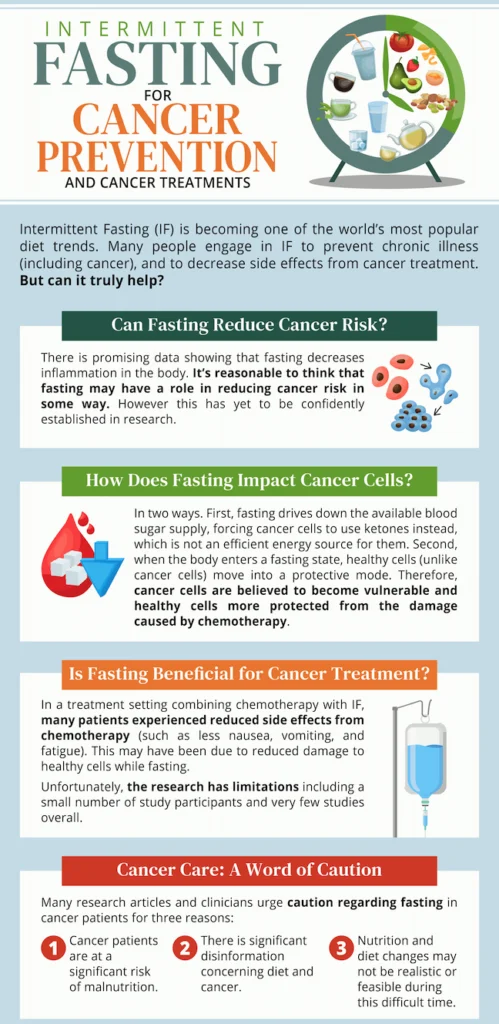
Further Info
A 2014 mini-review reported that restricting calories decreases IGF-1 levels, which may result in slower tumor development (https://bmcmedicine.biomedcentral.com/articles/10.1186/s12916-017-0873-x)
A 2019 review in people with cancer found that fasting reduced some of the side effects of chemotherapy and increased its effectiveness. The study suggested that fasting may deprive cancer cells of nutrients, making them more susceptible to the toxins in chemotherapy (https://www.ncbi.nlm.nih.gov/pmc/articles/PMC6530042/)
Intermittent fasting is a potential preventative measure to cancer, however, despite these potential benefits, it’s essential to recognize that intermittent fasting should not be considered a substitute for conventional cancer treatments. Instead, it may be viewed as a complementary approach that could support overall health and possibly enhance the effects of conventional therapies. Cancer treatment decisions should always be made in consultation with healthcare professionals who specialize in oncology. As the research on intermittent fasting and cancer is ongoing, it’s vital to stay informed about the latest scientific findings and consult with healthcare professionals before implementing any dietary changes or lifestyle interventions. Moreover, individual responses to intermittent fasting can vary from person to person, and the approach might not be suitable for all cancer patients. Some individuals may have specific nutritional needs or medical conditions that could be affected by fasting.
Longevity
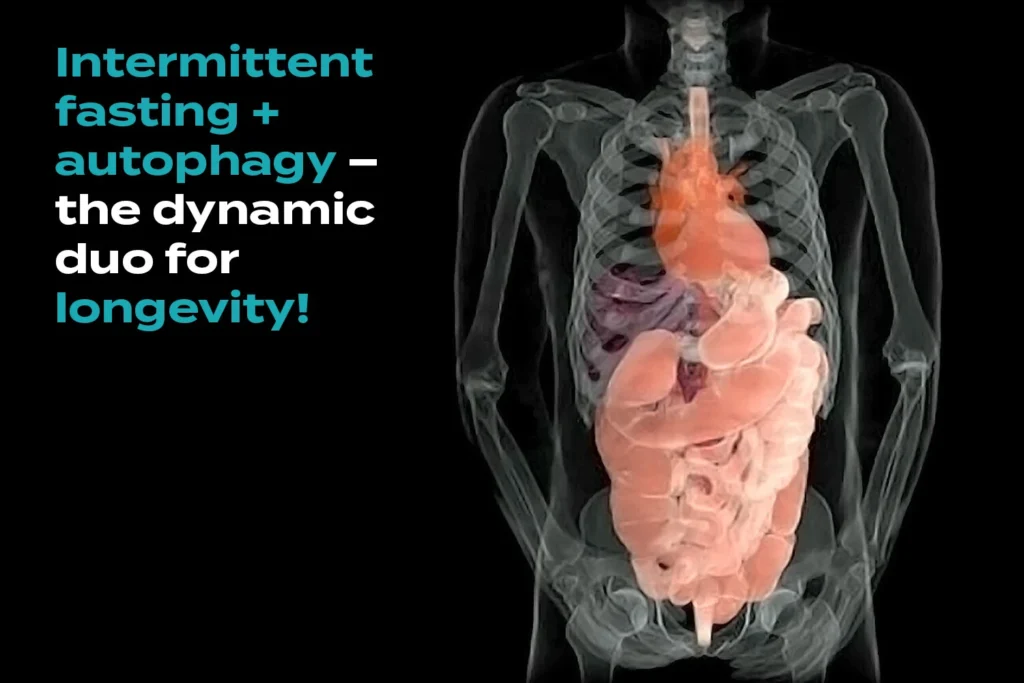
Intermittent fasting has actually been associated with potential benefits for long life. Here are some of the proposed ways intermittent fasting may contribute to longevity:
Cellular Repair & Maintenance: During fasting periods, the body undergoes a process called autophagy, where it clears out damaged cellular components and recycles them. This cellular “spring cleaning” may help improve the overall health and function of cells, potentially leading to better aging outcomes.
Reduction of Oxidative Stress: Intermittent fasting may help reduce oxidative stress, which is caused by an imbalance between free radicals and antioxidants in the body. High levels of oxidative stress can contribute to cellular damage and aging.
Enhanced Insulin Sensitivity: Intermittent fasting can improve insulin sensitivity, leading to better blood sugar control and a decreased risk of developing type 2 diabetes and other metabolic conditions associated with aging.
Improved Heart Health: As intermittent fasting may lead to weight loss and reductions in cardiovascular risk factors such as blood pressure and cholesterol levels, it could support heart health and reduce the risk of heart disease, a leading cause of mortality.
Anti-Inflammatory Effects: Chronic inflammation is linked to various age-related diseases. Intermittent fasting may help reduce markers of inflammation, potentially contributing to healthier aging.
Impact on Growth Hormones: Intermittent fasting can affect the secretion of growth hormones, such as human growth hormone (HGH), which plays a role in cell regeneration and repair.
Potential Impact on Longevity Genes: Some animal studies have suggested that intermittent fasting might influence certain genes associated with longevity and cellular stress resistance.
Further Info:
A 2016 review found that years of animal studies showed a link between restriction of calories and fewer diseases and longer life (https://www.mdpi.com/2076-328X/7/1/4/htm)
A 2011 study linked the hormone insulin-like growth factor-1 (IGF-1) to certain diseases that affect lifespan, such as cancer & type 2 diabetes (https://www.ncbi.nlm.nih.gov/pmc/articles/PMC3141390/)
A 2014 study found that eating proteins increases IGF-1 production. Fasting to restrict calories may be a way to decrease IGF-1 levels. This could potentially lower a person’s risk of chronic diseases and extend their lifespan (https://www.ncbi.nlm.nih.gov/pmc/articles/PMC3988204/)
It’s important to understand that while intermittent fasting shows promise for longevity, the overall impact on human lifespan may vary depending on various factors, including genetics, lifestyle and other health habits.
To promote longevity, it’s essential to consider other healthy practices alongside intermittent fasting, such as regular physical activity, a balanced and nutrient-rich diet, stress management and not smoking. Additionally, individuals considering intermittent fasting should consult with a healthcare professional before starting, as individual health conditions and needs should be taken into account for a safe and effective approach.
Tips for Successful Intermittent Fasting

Intermittent fasting can be made more beneficial and manageable with some helpful tips and tricks. Remember that individual experiences with intermittent fasting may vary, so it’s essential to find an approach that works best for you.
Here are some tips to consider:
Start Slowly: If you’re new to intermittent fasting, consider starting with a less restrictive approach, such as the 12:12 method (fasting for 12 hours and eating within a 12-hour window). Gradually increase the fasting duration as you become more comfortable with the process.
Stay Hydrated: Drink lots of water and calorie-free drinks, such as herbal teas, throughout the day, during both fasting and eating periods. Staying hydrated can help curb hunger, ensure you get enough electrolytes, sodium and potassium chloride and support your overall well-being.
Choose Nutrient-Dense Foods: Opt for nutrient-dense, whole foods during your eating window to ensure you’re getting all your essential vitamins and minerals. Eating foods that are high in fiber, vitamins, minerals and other nutrients helps to keep blood sugar levels steady and prevent nutrient deficiencies, so be sure to include plenty of fruits, vegetables, lean proteins, whole grains and healthy fats in your meals. A balanced diet will also contribute to weight loss and overall health
Vitamins: In the event you may not be eating enough nutrient-dense foods to get your daily dose of required vitamins, minerals and other nutrients your body needs to stay healthy, selecting good quality vitamin supplements is a great idea to offset the food you consume that may not be as healthy as you would like. We recommend a variety of organic vitamins that don’t include anything else except the actual organic vitamins and nothing else (no additives). Reach out to us for advise on which ones we feel are the healthiest and most beneficial to your health
Plan Meals Ahead: Plan your meals and snacks in advance to avoid making impulsive, unhealthy food choices when your eating window starts. Preparing meals ahead of time can save you time and help you stick to your eating plan.
Eat Balanced Meals: Ensure your meals contain a balance of protein, healthy fats and fiber-rich carbohydrates. This combination can help you feel more satiated and maintain stable blood sugar levels.
Listen to Your Body: Pay attention to your body’s hunger and fullness cues. If you’re genuinely hungry outside your eating window, it’s okay to adjust your fasting schedule occasionally or at least until you get more used to it.
Be Flexible: Intermittent fasting doesn’t have to be rigid. Be flexible with your schedule to accommodate social events or special occasions. You can always adjust your fasting hours on different days.
Avoid Thinking About Food / Stay Busy: Plan plenty of distractions to keep yourself occupied during fasting periods to minimize focus on food. Engage in activities, work, hobbies, or exercise to distract from hunger.
Support & Accountability: Use your Fit Club community advise and support, and to share your experiences, challenges and successes with intermittent fasting.
Track Progress: Keep a journal to track your weight, fasting hours, eating habits and how you feel throughout the process. This can help you identify patterns and make adjustments as needed.
Get Enough Sleep: Prioritize getting enough quality sleep. Lack of sleep can affect hunger hormones and make fasting more challenging.
Good Luck! We know you can do it, and we’re always here to help!
The Exercise

In the relentless rhythm of the open road where truck drivers traverse seemingly endless highways and byways, the importance of exercise for truck drivers cannot be overstated.
Beyond the horizon of miles logged and cargo hauled, lies a critical truth for the modern day nomads: the challenges of stress, a sedentary lifestyle and the rigors of long hours spent behind the wheel all add up to nothing short of a health crisis in the form of weight gain, muscle atrophy and a host of other serious health concerns.
Amidst the hustle of deadlines, where time zones blur and destinations are many, it’s easy for health and well-being to take a backseat. However, the only path is clear: frequent and regular exercise is not only a means of staying fit but a compass pointing toward longevity and vitality. It’s an essential lifeline to combat the adverse effects of the open road to help both your body and mind and greatly reduce the risk of high blood pressure, heart disease and diabetes.
From alleviating the physical strains of the profession to fortifying mental resilience, the benefits of exercise ripple far beyond the confines of the cab. As we steer through the reasons why truck drivers must embrace exercise, we embark on a transformative path that not only enhances their personal well-being but also safeguards their ability to navigate the roads ahead with strength, resilience and a renewed sense of purpose.
WARNING
Remember that individual fitness levels and health conditions vary, so if you have any pre-existing health conditions or concerns, it’s advisable to consult a healthcare professional before starting any new exercises.
After doing extensive research on how a trucker can exercise regularly while dealing with the restrictive lifestyle and lack of gym options, we’ve compiled a nice collection of exercises and routines designed exclusively for truckers to stay fit and active while on the road! With minimal space and equipment requirements, these simple yet effective exercises and routines can be done in and around your truck, ensuring you never miss a chance to prioritize your well-being.

Psychological Benefits of the Fit Club
The Fit Club offers a variety of psychological benefits to our members beyond just physical health improvements.
Here are some potential psychological benefits:
Social Support: Becoming a member of the Fit Club provides a sense of community and support. Sharing experiences, challenges and successes with like-minded individuals can reduce feelings of isolation and boost motivation. Fit Club members often understand each other’s struggles and can offer empathy and encouragement.
Accountability: Being part of the Fit Club encourages accountability. When members set goals together and check in regularly, they are far more likely to stay committed to their journey of getting fit. The fear of disappointing the group is a powerful motivator to stick to healthy habits.
Increased Motivation: Group activities, challenges and friendly competitions within the Fit Club foster a competitive spirit and motivate members to strive for better results. Seeing others make progress inspires individuals to push themselves harder.
Structured Routine: The Fit Club provides a structured routine, including workout routines and supporting media. This helps our members establish a sense of order in their lives, which is particularly beneficial for those struggling with consistency and discipline.
Positive Peer Pressure: Member peer pressure is positive at the Fit Club when it comes to health-related behaviors. The Fit Club’s focus on healthy habits influences our members to make better choices. When surrounded by others who prioritize health, members are more likely to adopt similar behaviors.
Improved Self-Esteem: As members make progress towards their weight loss goals, they experience an increase in self-esteem and self-confidence. Achieving milestones and receiving recognition from fellow club members greatly contribute to a more positive self-image.
Stress Relief: Engaging in physical activity and participating in group activities helps reduce stress and improve mood. Exercise releases endorphins, which are known as “feel-good” hormones that alleviate symptoms of anxiety and depression.
Skill Development: The Fit Club offers educational sessions on nutrition, exercise and lifestyle changes. Learning and developing new skills provides a sense of accomplishment and boost overall cognitive well-being.
Mindset Shift: Interacting with others who share similar goals can help individuals shift their mindset from a focus on quick fixes to adopting long-term, sustainable healthy habits. This shift in perspective leads to better mental well-being.
Sense of Belonging: Being part of a club that shares a common goal can create a sense of belonging and identity. This can be especially important for individuals who may have felt isolated due to their weight or health struggles.
Coping Strategies: The Fit Club provides a platform for members to share their coping strategies for dealing with challenges related to weight loss and healthy living. Learning from others’ experiences can equip individuals with effective ways to manage setbacks and obstacles.
It’s important to note that the combination of social support, accountability, motivation and a positive environment makes a significant difference in our members’ journeys to getting fit and overall mental well-being.
Equipment we Recommend
Bicycles
- Folding Mountain Bike
- 26” Wheels
- Full Suspension
- 21 Speed
- Rated 3.9 out of 5
- $139.80 + $99.99 Shipping
- Folding Mountain Bike
- 27.5″ Wheels
- Full Suspension
- 21 Speed
- Rated 3.8 out of 5
- $299 + Free Delivery
- Mountain Bike
- 26″ Wheels
- Full Suspension
- 21 Speed
- Rated 4 out of 5
- $197.49 + Free Delivery
Adjustable Dumbbells
- Adjustable from 11 lbs to 22, 33, 44 and 55 lbs
- Rated 4.8 out of 5
- $105.99 + $29.99 Shipping
- Adjustable from 15 lbs to 25, 35, 45 and 55 lbs
- Rated 4.5 out of 5
- $139.99 + $39.99
- Adjustable from 5 lbs to 7.5, 10, 12.5, 15, 17.5, 20, 22.5, 25, 30, 35, 40, 45, 50 and 52.5 lbs
- Rated 4.8 out of 5
- $214.97 + Free Delivery
Resistance Stretch Bands
Suspension Trainer System
- Rated 4.7 out of 5
- 21% Off from Original Price
- $79.10 + Free Shipping
Push-Up Bars
Ab Roller
Wrist Weights
Ankle Weights
Exercise Mat
Gyro Ball
- All Metal Design
- Auto-Start
- Weight: 15.5 oz
- Rated 4.1 out of 5
- $31.99 + Free Shipping
- All Metal Design
- Auto-Start
- Weight: 14.4 oz
- Rated 4.3 out of 5
- $29.99 + Free Shipping
- Transparent with Counter & Lights
- Auto-Start
- Rated 4.2 out of 5
- $19.99 + Free Shipping
Hand Grip Strengthener
- 5 Piece Kit
- Tension: 22 lbs to 132 lbs
- Rated 4.5 out of 5
- $9.99 + Free Shipping
- All Metal Design
- Tension: 55 lbs to 176 lbs
- Rated 4.8 out of 5
- $52.80 + Free Shipping
Jump Rope
- Weighted – 1 lb
- Tangle-Free Ball Bearing
- Aluminum Handle
- Adjustable Length
- Rated 4.5 out of 5
- $25.98 + Free Shipping
- Calorie Counter
- Ball Bearing
- Adjustable Length
- Alarm Reminder
- Rated 4.4 out of 5
- $13.79 + Free Shipping
Here is just one idea for an example routine, but feel free to read the exercise details below and make your own!
Begin with a dynamic warm-up, including arm circles, leg swings and trunk rotations.
Move on to bodyweight exercises such as squats, lunges, push-ups against the truck’s exterior and tricep dips using a sturdy step or bumper. When you’re done with those, hop inside and do some sit-ups.
For cardiovascular benefits, briskly walk or jog around your truck, the truck stop or shipper’s / receiver’s yard when you have a few minutes. Keep in mind that 11,000+ steps per day is best and about 32 full circles around a tractor trailer is about 1 mile.
To stretch and relieve tension, perform standing hamstring stretches, shoulder stretches and neck rolls.
Wind down with deep breathing exercises and cool down stretches for a rewarding and rejuvenating fitness experience, giving you the energy and resilience to conquer any road ahead.
Below, you’ll see details on a whole lot of the exercises truckers can do while on the job, so feel free to make your own routines and remember, the Fit Club is your constant companion to wellness – no gym required!
Cardio
Walk / Jog / Sprint
Truck drivers have a sedentary lifestyle due to the long hours spent sitting while driving. Incorporating walking or jogging exercises into their daily routine can provide numerous health benefits, both physically and mentally.
Jumping Jacks
Jumping jacks are a simple and effective cardiovascular exercise that provides various health benefits for truck drivers, who often spend long hours sitting and may have limited opportunities for physical activity.
Shadow Boxing
Shadow boxing offers several health benefits for truck drivers or anyone who leads a sedentary lifestyle. Truck drivers often spend long hours sitting and don’t have access to traditional forms of exercise.
Health Benefits of Cardio Exercises
Improved Cardiovascular Health: Cardio exercises are a great way to get the heart rate up and improve cardiovascular fitness. It is a very effective way to burn calories, manage weight and improve heart health. Regular cardio exercise stimulates blood flow throughout the body, which helps reduce the risk of blood clots and improves overall circulation, strengthens the heart muscle, lowers blood pressure and reduces the risk of heart disease.
Weight Management: Cardio exercises are an effective way to burn calories and manage weight. Even simple walking contributes to calorie expenditure, helping truck drivers maintain a healthier weight.
Improved Metabolism: Engaging in regular physical cardio activity boosts metabolism. Jumping jacks, for example, are a form of high-intensity interval training (HIIT), which is known to boost your metabolism even after the exercise is done. This is especially beneficial for truck drivers who struggle with weight management and may have a slower metabolism due to their sedentary lifestyle but don’t have access to a gym on the road.
Better Blood Sugar Control: Physical activity helps regulate blood sugar levels by enhancing insulin sensitivity. This is crucial for truck drivers, as they often face an increased risk of developing type 2 diabetes due to prolonged sitting and unhealthy eating habits.
Reduced Risk of Musculoskeletal Issues: Cardio exercises help alleviate muscle stiffness and tension that can result from long hours of sitting. Engaging in these exercises improves overall flexibility and reduces the risk of musculoskeletal issues.
Enhanced Mood, Stress Relief & Mental Well-Being: Exercise has a positive impact on mental health by releasing endorphins, which are natural mood enhancers. Engaging in regular physical activity helps truck drivers experience greatly reduced stress, anxiety, mood swings and depression, improving overall mental well-being.
Release of Tension: Cardio exercises allow individuals to release built-up tension and frustration, serving as an outlet for emotional release and relaxation.
Increased Energy Levels: Engaging in regular physical activity boosts energy levels and combats feelings of fatigue. This is especially important for truck drivers who need to stay alert and focused during long hours on the road.
Better Sleep Quality: Regular exercise improves sleep quality by promoting more restful sleep and helps regulate sleep patterns. Adequate sleep is crucial for truck drivers to maintain alertness and cognitive function while driving.
Enhanced Lung Function: Cardio exercises involve rhythmic deep breathing patterns that help improve respiratory function and lung capacity. This is especially beneficial for truck drivers who might spend prolonged periods in confined spaces with limited ventilation.
Reduced Risk of Chronic Diseases: Regular physical activity lowers the risk of various chronic diseases, including heart disease, stroke, obesity and certain types of cancer. Incorporating cardio into your daily routine will contribute to long-term health benefits.
Better Muscular Endurance: Doing cardio exercises engages a variety of muscle groups, including the upper body like arms, shoulders, back, legs and core. Over time, this leads to improved muscular endurance and overall strength, which is beneficial for tasks related to truck driving and daily activities.
Joint Mobility: The rhythmic motion of cardio exercises helps improve joint mobility and flexibility, which is especially beneficial for truck drivers who spend long hours sitting in the same position.
Calorie Burn: Cardio exercises are fairly intense due to them being a whole body workout and therefore lead to a high calorie burn. Engaging in these exercises regularly contributes to weight management and fat loss, which is particularly important for individuals with a sedentary job like truck driving.
Improved Posture: Many truck drivers struggle with poor posture due to prolonged sitting. Cardio exercises require proper body alignment and stance, which helps improve posture and reduces the risk of musculoskeletal imbalances.
Enhanced Coordination & Balance: Cardio exercises generally involve coordinated movements of the upper and lower body, which improves overall coordination and balance. This is particularly beneficial for truck drivers who may experience stiffness from sitting for extended periods.
Improved Focus & Concentration: Cardio exercises require mental focus and concentration on technique and form. Regular practice enhances mental clarity and attention, improving truck drivers’ alertness on the road.
Quick & Convenient: Cardio exercises require minimal space and no special equipment, making them a convenient option for truck drivers. They can be easily integrated into rest breaks or stops along your daily route, making them a convenient option for on-the-go fitness.
Member Support & Interaction: Since you’re part of the Fit Club, you have lots of members who are experiencing similar issues, so creating daily goals or contests for your group or even exercising in virtual groups or physically at truck stops, cardio exercises provide a simple and fun way to engage with fellow driver members, encouraging not only your motivation but also camaraderie, which will combat feelings of isolation.
Stretching
Arm Circles
Arm circles are a simple and effective exercise that can offer several health benefits for truck drivers who are looking to improve their upper body mobility and strength.
Leg Swings
Leg swings are a simple yet effective exercise that can offer various health benefits for truck drivers who often spend long hours sitting and may experience reduced circulation and muscle stiffness.
Trunk Rotation
Trunk rotation exercises offer various health benefits for truck drivers, who often spend long hours seated and may experience stiffness and discomfort due to prolonged driving. These exercises specifically target the muscles in the torso, spine and lower back.
Trunk Side Bends
Trunk side bends, also known as lateral trunk flexion exercises, offer several health benefits for truck drivers or anyone who spends long periods sitting. These exercises target the muscles along the sides of the trunk and the core.
Standing Hamstring Stretches
Standing hamstring stretches offer several health benefits for truck drivers, who often spend extended periods sitting while driving. Incorporating these stretches into their daily routine will help alleviate some of the negative effects of prolonged sitting and improve overall physical well-being.
Shoulder Stretches
Shoulder stretches offer several health benefits for truck drivers who often spend long hours sitting and driving. The repetitive nature of driving can lead to muscular tension and stiffness in the shoulders and upper back. Incorporating regular shoulder stretches into their daily routine helps alleviate discomfort and promote overall well-being.
Neck Rolls
Neck rolls, or neck stretching exercises, offer some health benefits for truck drivers or anyone who spends long periods of time sitting and driving. It’s important to perform these exercises safely and within a comfortable range of motion.
Toe & Sky Touch Stretch
The Toe & Sky Touch Stretch is just what it sounds like: you bend down and touch your toes and then back up and touch the sky. It offers several health benefits, particularly for truck drivers who often spend long hours sitting and driving. This stretch helps target various muscle groups and promotes flexibility, which counteracts some of the negative effects of prolonged sitting.
Swimmer's Stretch
This is a dynamic stretch that provides several health benefits for truck drivers or anyone who spends prolonged periods sitting. It focuses on stretching the muscles of the upper body, particularly the shoulders, chest and back. For truck drivers who spend a lot of time behind the wheel, this exercise helps counteract the effects of prolonged sitting and promotes overall well-being.
Wrist, Hand & Finger Stretch
Wrist, hand and finger stretches provide numerous health benefits for truck drivers who spend extended periods of time behind the wheel. Prolonged driving can lead to discomfort and potential issues like carpal tunnel syndrome, stiff joints and muscle fatigue. Incorporating regular stretches into your daily routine helps alleviate these problems.
17 Stretches for Drivers
Feel achy and tight after a long day of driving? Try incorporating these 17 stretches for truck drivers, demonstrated and explained by Atlas Physical Therapist Caleb
Neck & Shoulder Stretches
Neck & Shoulder Stretches for Truck Drivers, by Living on the Road
Health Benefits of Stretching Exercises
Dynamic Stretching: Dynamic stretching exercises can be particularly beneficial before or after long hours of driving, and can serve as an effective warm-up exercise before engaging in more intense physical activities. They help warm up the muscles and joints by increasing the blood flow, preparing them for movement and reducing the risk of injury.
Tension / Stiffness Relief: Truck drivers often experience tension, knots and discomfort in the shoulders, neck, joints, upper and lower back, as well as stiffness, muscle imbalances and reduced range of motion in their spine due to prolonged sitting while holding the steering wheel with the neck in a fixed position. Stretching exercises help alleviate tension, increase mobility and flexibility, and alleviate muscle stiffness in these and other areas, strengthening muscles and promoting a more enhanced and fluid range of motion, relaxation and reducing the risk of discomfort, injury and pain.
Core Muscle Activation / Posture: Stretching exercises engage the core muscles, and a strong core is essential for maintaining muscle strength, preventing muscle imbalances, helping stabilize the body and overall better body mechanics. This counteracts the negative effects of the hunched-forward slouching posture and contributes to strengthening the core and engaging the muscles that support, maintain and improve proper posture both during driving and when they’re out of the truck, alleviating strain on the spine and supporting the lower back, maintaining muscle balance while reducing the risk of strains, injury and developing musculoskeletal issues.
Enhanced Blood Circulation: Stretching exercises help stimulate blood flow to the muscles, tissues and joints. Improved circulation reduces the risk of muscle stiffness, fatigue, cramping and other discomforts associated with prolonged sitting, as it delivers oxygen and nutrients to the muscles, aids in waste product removal and contributes to better overall cardiovascular health. This is particularly important for individuals who have a sedentary job like truck driving, as prolonged sitting can lead to reduced blood flow, which can contribute to issues such as blood clots and varicose veins.
Increased Energy & Alertness: Stretching exercises invigorate the body by increasing blood flow and oxygen delivery to the brain and muscles. This leads to improved alertness and energy levels, which is beneficial for truck drivers who need to stay focused and attentive on the road and can easily be incorporated during rest breaks to help combat fatigue or sluggishness that occur after long periods of driving.
Stress Reduction: Engaging in simple stretching exercises has a positive impact on mental well-being. Taking a few minutes to move and focus on the body provides a brief break from the demands of driving.
Relaxation, Stress Relief & Mood Enhancement: Physical activity, such as stretching, has a calming effect on the body, mind and the nervous system as it triggers the release of endorphins, which are natural mood enhancers known as “feel-good” hormones. Incorporating these exercises into your daily routine contributes to relaxation, mindfulness, improved mood and reduced stress levels, promoting mental well-being, which is important for individuals in high-stress professions like truck drivers who spend extended periods of time on the road.
Overall Health & Well-Being: Incorporating regular movement and exercise into your daily routine encourages mindfulness and awareness of the body’s needs, which have positive effects on overall health and well-being. Taking the time to perform stretching exercises offers mental refreshment and alleviates some of the physical strain associated with long hours behind the wheel, contributing to your physical and mental health.
Enhanced Mind-Body Connection: Performing stretching exercises involves focusing on your body’s movements, sensations and breathing while promoting mindfulness and encouraging individuals to become more aware of their connection between the body and mind. This increased mind-body connection leads to better posture habits, a greater ability to recognize and address discomfort or tension, helps become more attuned to body’s needs and promotes overall well-being.
Better Breathing: Stretching exercises encourage deep breathing and expansion of the chest and ribcage. Improved breathing patterns enhance oxygen intake and promote relaxation.
Enhanced Balance & Coordination: Stretching exercises involve controlled lateral movement, which improves balance and coordination. This is particularly important for truck drivers, as maintaining balance can be challenging when navigating uneven terrain or handling heavy packages.
Better Sleep: Stretching before and/or after driving helps relax the body and prepare it for rest. Improved sleep quality contributes to overall well-being and alertness while on the road.
Relieve Headaches: Tension headaches are common among individuals who spend long hours driving or sitting. Stretching exercises help relieve tension, reducing the frequency and intensity of tension headaches.
Improved Digestion: Some people find that stretching helps stimulate digestion by promoting movement in the abdominal area and massaging internal organs.
Quick, Convenient & Accessible: Stretching exercises are easy to perform and require minimal space and equipment. They’re convenient for truck drivers who don’t have access to a gym or exercise equipment on the road and are a quick and easy way to get some quick stress relief and energy during breaks.
Breathing
Deep Breathing Exercises
Deep breathing exercises can offer several health benefits for truck drivers, who often spend long hours on the road in a sedentary and potentially stressful environment.
3 Most Effective Pranayamas
Pranayama is a breath-control technique. In Sanskrit, pran means life and ayama means way. Pranayama can help you regulate your system, alter your mood and ensure longevity. These pranayamas are simple, but very effective tool for relaxation.
Calm your Anxiety in 2 Minutes
Here’s a great little trick for calming your body and mind in a matter of minutes. It’s so simple, yet so effective. Take 5 breathing helps you slow down, deepen your breath, and redirect your focus.
Health Benefits of Deep Breathing Exercises
Stress Reduction: Long hours of driving and potential traffic congestion can lead to elevated stress levels. Deep breathing exercises activate the body’s relaxation response, reducing stress hormones like cortisol and promoting a sense of calm and relaxation.
Improved Mental Clarity: Deep breathing increases oxygen intake and promotes better blood circulation. This improves cognitive function, mental clarity and alertness, which are crucial for safe and effective driving.
Enhanced Respiratory Function: Regular deep breathing exercises strengthen the respiratory muscles and improve lung capacity. This leads to better oxygen exchange, reducing the risk of fatigue and enhancing overall respiratory health.
Lower Blood Pressure: Deep breathing activates the body’s parasympathetic nervous system, which helps lower blood pressure. For truck drivers who may be at risk of hypertension due to prolonged periods of sitting and stress, deep breathing can contribute to better cardiovascular health.
Boosted Immune System: Chronic stress and inadequate oxygen intake can weaken the immune system. Deep breathing supports the immune system by reducing stress and increasing oxygen levels, helping truck drivers fend off illnesses more effectively.
Relief from Physical Discomfort: Sitting for long periods can lead to physical discomfort and muscle tension. Deep breathing exercises help alleviate muscle tension, promote relaxation and reduce the risk of chronic pain issues.
Enhanced Digestion: Stress and a sedentary lifestyle can negatively impact digestion. Deep breathing can stimulate the parasympathetic nervous system, promoting healthy digestion and reducing gastrointestinal issues.
Better Sleep Quality: Poor sleep is a common issue among truck drivers. Deep breathing exercises before bedtime help relax the body and mind, promoting better sleep quality and helping drivers feel more rested.
Emotional Regulation: Truck drivers often face isolation and loneliness during their long journeys. Deep breathing exercises help regulate emotions, manage feelings of loneliness and improve overall mood.
Improved Focus & Concentration: Deep breathing enhances oxygen delivery to the brain, which improves focus, concentration and decision-making abilities. This is essential for safe and effective driving.
Reduction in Muscle Tension: Long hours of sitting can lead to muscle tension, particularly in the neck, shoulders and back. Deep breathing exercises combined with gentle stretches help alleviate tension and reduce discomfort.
Mind-Body Connection: Engaging in deep breathing exercises encourages truck drivers to be more mindful of their body’s needs. This heightened awareness leads to healthier lifestyle choices, such as staying hydrated and taking regular breaks.
Notes:
Incorporating deep breathing exercises into a truck driver’s routine doesn’t require much time and can be done while driving or during breaks. Simple techniques like diaphragmatic breathing, box breathing or mindfulness-based breathing can be effective. Encouraging truck drivers to prioritize their well-being through deep breathing exercises contributes to better physical and mental health, ultimately enhancing their ability to perform their job safely and comfortably.
Bodyweight Exercises
Squats
Squats are a highly effective compound exercise that offer numerous benefits for overall strength, muscle development and functional fitness. They primarily target the lower body and engage core muscles for stability, but you can also expect your quadriceps, hamstrings, glutes, adductors and calves to get a workout as well. Remember that proper form is crucial for maximizing the benefits of squats and minimizing the risk of injury. If you’re new to squats, it’s advisable to start with bodyweight squats before progressing to weighted squats.
Lunges
Lunges are a versatile and effective exercise that offers a range of benefits that primarily target the lower body muscles while also engaging the core for stability. They can also be modified to target different muscle groups based on your form and variations, like the quadriceps, hamstrings, glutes, calves, adductors & abductors, core muscles and the erector spinae. For instance, a forward lunge might emphasize the quadriceps more, while a reverse lunge might engage the glutes and hamstrings to a greater extent. As with any exercise, it’s important to maintain proper form of all the different variations to prevent injury. If you’re new to lunges, consider starting with bodyweight lunges and gradually adding resistance as you become more comfortable.
Push-Ups
Push-ups are a versatile and effective bodyweight exercise that offers numerous benefits and work several muscle groups, such as your chest, shoulders, triceps, core, back and stabilizer muscles and glutes. It’s important to perform push-ups with proper form to avoid strain or injury. If you’re new to push-ups, you can start with modified variations (e.g., knee push-ups) and gradually progress to standard push-ups as you build strength.
Here are some ideas based on your fitness level:
Beginner: place hands on the side of the truck with as much lean as you can handle
Intermediate: place hands on the truck step and do as many as you can handle
Advanced: place hands on the ground, keep your back straight and your elbows as close to the body as possible, do as many as you can handle
Tricep Dips
Triceps dips are a bodyweight exercise that primarily targets the triceps brachii muscles, the muscles located on the back of your upper arms, but they also engage a range of supporting muscles, making them a valuable compound exercise for upper body strength and stability. These muscles include the pectoralis major, deltoids, rhomboids, lats, core muscles and traps. Remember to maintain proper form and engage these muscles correctly to maximize the benefits of the exercise while minimizing the risk of injury. Keep your shoulders down and back, your elbows pointing backward and your core engaged. As you lower your body, aim for a 90-degree angle at your elbows before pushing back up.
Beginner: use the trailers’ icc bumper and bend your knees 90 degrees
Advanced: use the cab steps with knees fully extended
Seated Leg Pull-Ins / Knee-Ups
The Seated Bench Leg Pull-In is a variation of the leg pull exercise that targets the abs, specifically the lower abs, and can be performed while sitting on a sleeper bed or chair. It is believed to be a better exercise than plain crunches and by incorporating it into your routine, you specifically target the lower abs to lose more belly fat and for better muscle definition.It’s a great exercise to not only work on your abs but also engage the obliques, hip flexors, legs and stabilizer muscles of the core. Like all other exercises, good results and targeting specific muscles will depend on proper form.
Pull-Ups
If you can set it up in your truck by doing something like securing a bar between the top cabinets, pull-ups are a highly effective bodyweight exercise that offers a range of benefits for both upper body strength and overall fitness. They primarily target the muscles of the upper body and are particularly effective at working the latissimus dorsi (lats), biceps brachii, rhomboids, trapezius, deltoids, forearms and grip strength. It’s worth noting that pull-ups can be challenging, especially for beginners. Always prioritize proper form.
Plank
The plank exercise is a versatile and effective bodyweight exercise that primarily targets the core muscles while also engaging various other muscle groups. Planks can be modified to suit various fitness levels, making them suitable for beginners and experienced exercisers alike. Regular practice of planks, along with a well-rounded fitness routine, contributes to a stronger core, improved posture and enhanced overall fitness. They primarily target the rectus abdominis, transverse abdominis, obliques, erector spinae, shoulders, triceps, glutes and quadriceps.
Russian Twist
Russian twist is a popular exercise that offers several benefits for your core and overall fitness. It primarily targets the muscles in your abdominals and obliques, but it also engages other muscle groups to provide a well-rounded workout. Remember that the intensity of muscle engagement can vary depending on factors such as your form, the weight or resistance used (if any), and your overall fitness level. It’s important to perform russian twists with proper form to avoid straining your lower back and to get the most benefit from the exercise. Start with a weight that allows you to maintain good form and gradually increase the resistance as you become more comfortable. The russian twist primarily targets the rectus abdominis (the “six-pack” muscle), transverse abdominis, erector spinae and hip flexors.
Step-Ups
Step-ups are a type of exercise that involves stepping onto a raised surface with one leg and then lowering the opposite leg back down. This movement can be done using the truck’s step platform. To ensure a balanced lower body workout, it’s a good idea to combine step-ups with other exercises that target different muscle groups. Remember that proper form is crucial to avoid injury and maximize the benefits of step-ups. They primarily target the quadriceps, glutes (gluteus maximus), hamstrings, calves (gastrocnemius and soleus), hip flexors, adductors, erector spinae and core muscles.
High Knees
High knees exercises can offer several health benefits for truck drivers who often spend long hours sitting and driving. It’s important for truck drivers to prioritize their health and find ways to incorporate physical activity into their daily routines. High knees are a dynamic exercise that primarily targets the muscles of the lower body, particularly the legs, but they also engage the core and upper body to some extent. The primary muscles include the quadriceps, hamstrings, hip flexors, calf muscles, core muscles, gluteal muscles, lower back muscles, shoulder muscles and upper body and arm muscles. Alongside high knees exercises, other forms of exercise, stretching and healthy eating habits contribute to overall well-being and reduce the health risks associated with a sedentary lifestyle.
Mountain Climbers
Mountain climbers are a dynamic full-body exercise that engages multiple muscle groups and offers several health benefits for truck drivers, who often spend long hours sitting and may have limited opportunities for physical activity. They provide a comprehensive workout due to their ability to simultaneously target several muscle groups and elevate the heart rate. They are often incorporated into cardiovascular and strength training routines, and can be modified to match different fitness levels. The exercise involves simulating a climbing motion, which not only targets the muscles of the lower body but also requires core engagement and upper body stability. The main muscle groups that mountain climbers work are glutes and shoulders, arms, chest, back, leg, hip, stabilizer and core muscles. Incorporating mountain climber exercises into your daily routine helps mitigate the negative effects of prolonged sitting and improves overall health. Learning proper form and technique for mountain climbers is crucial to avoid injury and ensure maximum benefits.
Burpees
Burpees are a high-intensity, full-body exercise that offer several health benefits, especially for truck drivers who often have a sedentary lifestyle due to long hours of driving. It engages multiple muscle groups, and is known for its’ effectiveness in providing both cardiovascular benefits and strength training. The main muscle groups that burpees work are the chest, shoulders, triceps, calves, legs, hips, back and core muscles, as well as your cardiovascular system. Due to the comprehensive engagement of various muscle groups and the cardiovascular aspect of the exercise, burpees are considered a highly effective compound movement that can provide a time-efficient way to work on both strength and cardiovascular fitness. However, because they can be intense, individuals should ensure that they are performing burpees with proper form and technique to avoid strain or injury. Beginners can start with modified versions or fewer repetitions and gradually increase the intensity as they become more comfortable and experienced with the exercise.
Glute Bridges
Glute bridges are a versatile exercise that offers several health benefits for truck drivers or anyone who spends long hours sitting. They are an effective exercise that primarily target the muscles of the glutes (buttocks) and hamstrings, which are important for hip extension, pelvic stability and overall lower body strength, while also engaging several other muscles for stability and support. The main muscles worked during glute bridges include the Gluteus Maximus, Hamstrings, Erector Spinae, Core Muscles, Adductors, Quadriceps, Hip Stabilizers, Spinal Extensors, Gluteus Medius & Minimus and Latissimus Dorsi. It’s important to perform glute bridges with proper form to ensure that the targeted muscles are effectively engaged and to prevent any unnecessary strain on the lower back or other areas. While glute bridges provide great benefits, they should be part of a well-rounded exercise routine that includes cardiovascular exercise, stretching and other strength-training exercises.
Heel & Toe Raises
Heel & toe raise exercises can offer several health benefits for truck drivers who spend long hours sitting and driving. To help counteract some of those negative effects, heel raise exercises primarily target the muscles of the calves, specifically the gastrocnemius and soleus muscles. These muscles are responsible for pointing the foot downward (plantar flexion) and are heavily engaged when you raise your heels off the ground. The additional muscles involved include the plantaris, tibialis posterior, flexor hallucis longus and flexor digitorum longus and peroneals. It’s important to note that the exact muscles engaged can vary based on factors such as foot positioning, range of motion and exercise variation. For instance, performing the heel raise with a straight knee versus a slightly bent knee can change the emphasis on different parts of the calf muscles. Keep in mind that while heel raises can offer these benefits, they should be just one part of a comprehensive routine to address the health challenges faced by truck drivers. Incorporating other exercises that target different muscle groups, as well as practicing good ergonomics, taking regular breaks to stretch and walk, staying hydrated and maintaining a balanced diet, can collectively contribute to better overall health and well-being for truck drivers.
BONUS
Get A Chair & Watch Your Stubborn Belly Fat Burn Off (SEATED ONLY) – by 5 Minute Fitness
Dumbbell Exercises
Concentration Bicep Curls
Concentration bicep curls are a specific type of bicep curl exercise that is performed with a focus on isolating the bicep muscles. This exercise involves sitting down and curling a dumbbell with one arm at a time, using the opposite arm to provide support on the same side thigh. It’s important to remember that no single exercise can provide a complete and balanced workout for all muscle groups. Incorporating a variety of exercises that target different muscle groups, along with proper nutrition and rest, is key to achieving overall health and fitness goals. Always use proper form and start with an appropriate weight so you don’t hurt yourself.
Tricep Extensions
Tricep extensions are exercises that primarily target the triceps brachii muscles located on the back of the upper arm and consist of the lateral head, medial head and the long head. It is also supported by the deltoids, upper back muscles and the forearms. It’s important to perform tricep extensions with proper form to effectively target the triceps muscles while minimizing the risk of injury.
Single Arm Bench Press
The single-arm dumbbell bench press is a variation of the traditional bench press where you use only one arm at a time. Start with laying on the bed with one arm hanging off, pick up the dumbbell and do as many as you can, then switch to the other arm and keep track of how many you did to see your improvement over time. This exercise primarily targets the chest muscles, but it also engages several other muscle groups for stability and support like the shoulders, triceps, stabilizer muscles and the core. As with any exercise, proper form and technique are essential to maximize benefits and minimize the risk of injury.
Single Arm Front Raise
The single-arm dumbbell front raise is an exercise primarily targeting the front deltoid muscles of the shoulder, but it also engages several other muscles to assist in stabilizing and controlling the movement like the lateral deltoids, triceps and the upper trapezius. It involves lifting a dumbbell from a hanging position in front of your body to shoulder level. Remember to use an appropriate weight that challenges you but allows you to maintain proper form. If you’re new to this exercise, start with a lighter weight and gradually increase as you become more comfortable and stronger.
Rear Delt Dumbbell Row
The Single Arm Rear Delt Dumbbell Row is an effective exercise that primarily targets the rear deltoid muscles, which are located on the back of your shoulders. Additionally, this exercise engages several other muscles to provide stability and support during the movement, such as the trapezius, rhomboids, lats and biceps. As with any exercise, it’s important to maintain proper form and start with an appropriate weight to avoid injury.
BONUS
How do you stay fit and healthy while driving a truck?
In this video, Dean shows us what workout tools and fitness equipment he takes on the road with him and how to utilize it. He wants to do something healthy with his downtime at a truck stop or while waiting to be loaded or unloaded at a company. Dean does a variety of things to remain in shape, and he’d like to share some advice with you drivers who want to get fit and healthy!
Exercise while Driving
Gyro Ball Exercise
Gyro ball exercises, also known as gyroscopic exercise devices or power balls, involve using a handheld spinning ball to perform various movements that engage and challenge different muscle groups, such as the muscles in your wrists, forearms, shoulders, grip muscles and can even engage your core. They’re not only good for building arm strength but can even help with an injury rehabilitation. Remember that while gyro ball exercises can offer various benefits, it’s important to use proper technique and start with appropriate resistance levels. Gradually increase the intensity as your strength and control improve to avoid overexertion or injury.
Hand Grip Exerciser
Hand gripper exercises involve squeezing a spring-loaded or resistance-based device using your hand muscles. These exercises primarily target the muscles of your forearm and hand. Remember that while hand gripper exercises can provide numerous benefits, they should be a part of a well-rounded fitness routine that includes cardiovascular exercise, flexibility training and other strength exercises for balanced physical development.
Shoulder Blade Squeeze
Shoulder blade squeeze exercises primarily target the muscles of the upper back, including the trapezius, rhomboids and posterior deltoids. These exercises are beneficial for improving posture, strengthening the upper back muscles and reducing the risk of shoulder and neck pain. Remember to maintain proper form and avoid straining your neck or upper body while performing these exercises.
Shrug
The shrug is very common and easy to implement, and it’s one of the best exercises to activate the trapezius which are located in the upper back and neck region, as well as the levator scapulae. These muscles play a crucial role in shoulder movement, neck stabilization and overall upper body posture. When performing shrug exercises, it’s essential to use proper form to avoid straining the neck and shoulders.
Seated Heel & Toe Raises
Seated heel and toe raises are exercises that primarily target the muscles of the lower legs, specifically the calves. These exercises can provide several health benefits and contribute to overall lower body strength and stability. The best part is that these can be done while seated, so throw your truck into cruise control and get to work! Raise your heels, hold it up for 5 to 10 seconds and switch to toe raises and do the same. Do that as much as you can handle and watch your muscles get stronger while you drive.
Seated Muscle Squeeze
A good way to exercise your muscles while driving is to squeeze them as hard as you can and hold for about 15 to 30 seconds and relax. Good muscles to do this with are the chest, abs and your glutes (your butt). Repeat it as often and as many times a day as you are able and you’ll be on your way to getting stronger.
Seated Pelvic Tilt
Seated pelvic tilts are a simple yet effective exercise that offers several benefits, particularly for improving core strength, flexibility and posture. As with any exercise, it’s essential to perform seated pelvic tilts with proper form to avoid strain or injury.
Seated Knee Lifts
Seated knee lift exercises, also known as seated leg raises, are a form of resistance exercise that primarily target the muscles of the upper, deeper and lower abdominals and hip flexors. Remember that while seated knee lifts offer several benefits, it’s important to include a variety of exercises in your routine to ensure balanced muscle development and overall fitness.
Tips to Avoid Back Pain
If you don’t make sure you’re sitting properly while driving, you can cause chronic lower back or neck pain. In this video, Eric demonstrates how to adjust the driver’s seat to lessen spine strain and avoid back pain. Truck drivers can avoid back pain by making sure to sit back in the seat comfortably and ensure your arms are comfortable and relaxed, by moving the seat forward or backward as needed. Make sure to adjust the seat up or down to make sure the backs of your legs touch the seat lightly. By following this simple advice, drivers can lessen the chances of back pain and feel healthier and less stressed.

